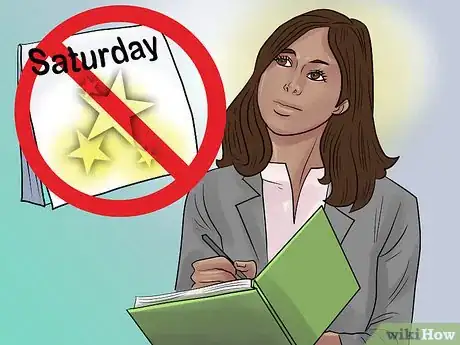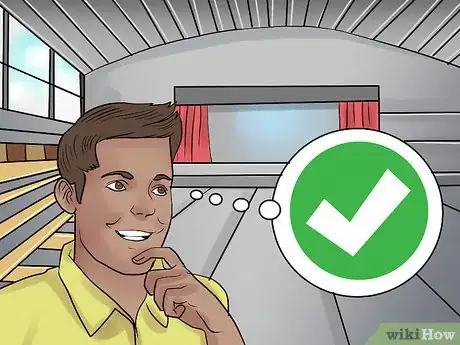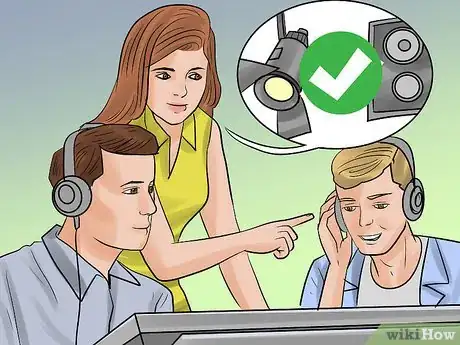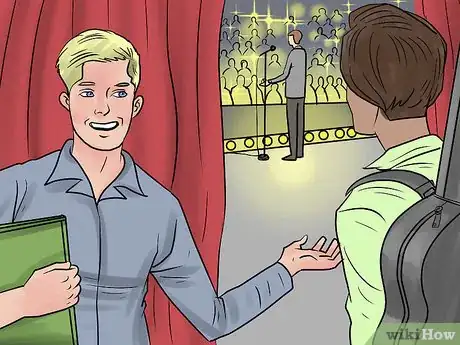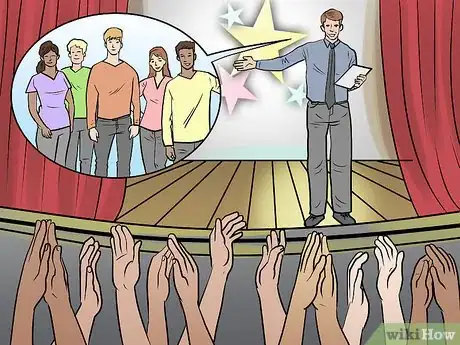This article was co-authored by wikiHow Staff. Our trained team of editors and researchers validate articles for accuracy and comprehensiveness. wikiHow's Content Management Team carefully monitors the work from our editorial staff to ensure that each article is backed by trusted research and meets our high quality standards.
There are 12 references cited in this article, which can be found at the bottom of the page.
This article has been viewed 43,987 times.
Learn more...
Hosting a talent show is a great way to bring students, teachers, and parents together for a night of entertainment! The children will relish the opportunity to compete and cheer one another on, and the buzz generated by your talent show can open the door to being able to host similar events in the future. You might even make it an annual tradition.
Steps
Getting Approval
-
1Get support from school leaders. The principal, counselors, and heads of the music, art, and theater departments are your most likely sources of support.
- As teachers are already engaged in the creative arts, it's natural for them to be involved in your show.
- In addition, students can see by their instructors' enthusiasm that their school is committed to developing their overall quality of life, as well as their curriculum.[1]
-
2Highlight the benefits of the creative arts to the student body. If teachers or administrators are reluctant to sanction a talent show, argue that such initiatives can have tangible academic benefits.Advertisement
-
3Be sure that the show participants follow school rules. The content of the performances, dress code, and hours of operation should be taken into account when scheduling and selecting the acts.[4]
- Each school's code of conduct differs, but mature content and dress will probably be prohibited.
- You may also have to obtain permission for utilizing school grounds after hours for planning, rehearsing, or putting on the show.
-
4Recruit help. Running any event is a huge amount of work and nobody can do it alone. You need a team of reliable people to help you.
- Make a list of everything you need help with and assign volunteers to work on each item. This can be everything from selling tickets to promotions, set-building, lighting, stewarding, and backstage logistics.
- If a role is particularly vital, have a back-up person to help if something goes wrong at the last minute.
- Don't be afraid to delegate. Trust your volunteers and assign them enough help to accomplish their tasks.[5]
Setting the Date and Location
-
1Allow plenty of time to plan the show. Beginning to plan several months from the show date is usually ideal to let guests clear their schedules in advance. Four to six months should be plenty of time.
- If RSVP's are required, you'll need to determine a timeline for that as well, as the RSVP date will need to be included on the flyers and invitations.
-
2Avoid scheduling the show on or near holidays and weekends. You'll want a great turnout, so you won't want anyone to miss the show by being out of town.
- Some students might not have transportation during the evenings or weekends, so it's crucial to keep the show as close to school hours as possible.
-
3Avoid double-booking with other school events. Both students and parents will be more likely to attend if you're aware of the other activities going on each week.
- Coordinate with the school's administrators to avoid conflicts with other school events such as athletics, other performances, or faculty meetings.
-
4Decide where to hold the show. The school itself will be easiest for everyone to access, and everyone will feel more comfortable in a familiar space.
- An auditorium or gym are large enough for a sizable audience and have plenty of room for a make-shift stage.
- The parking lot, school grounds, or a sports field can be used as long as weather permits.
-
5Ask local businesses or public spaces for help. If you can't host the event at your school, many facilities will be willing to help a local school if you can demonstrate that the event will be efficiently run and will benefit the community as a whole.
Raising Funds
-
1Make a budget. Project all of your possible costs, including the venue, technical aspects such as lighting or sound, transportation, and compensating any staff involved in setup or cleanup.
- Include any assets you are able to gain either from the school or from outside donations.
- Allocate the right amount of funds for each budget item. If any one item is significantly more expensive than the others, you may need to review whether it is necessary.[6]
-
2Encourage parents to donate. Parents of students participating in the show will want to support their kids, as will their friends.[7]
- Place donation jars in the school's main offices, classrooms, or cafeteria.
-
3Sell tickets. If you are having trouble meeting the costs of putting on the talent show, a small ticket fee might be your best option.[8]
-
4Organize a fundraiser. This can be a big addition to your workload, but if you still have outstanding costs you might find it necessary.[9]
Publicizing the Show
-
1Send out invitations. The student body, teachers, and parents should be the first to get the details about the show. Sending an invitation home can provide a good reminder, and encourage parents to get involved.
- Include clear information about the dates for the auditions, RSVP, and the show itself. Also highlight the location, theme, and contact information, and give credit to sponsors or donors.
-
2Make flyers. Use this as a fun DIY project that can get students involved with their own artwork and writing.[10]
-
3Ask teachers to make announcements in class. Perhaps the most direct way to spread the word, seeing their instructors excited about the show will make the students even more excited to participate or attend.
-
4Employ social media. Many schools have incorporated the use of social media in classrooms, so take advantage of its speed and efficiency to advertise your event.
- Not only students, but parents, are active on social media. Instead of parents having to ask what their children are up to on a daily basis, it's more effective to show them.[11]
-
5Send out e-mails. Mass e-mails to the student body and parents can serve as a quick method of communication. As the date of the show approaches, this might be the best way to send a quick reminder.[12]
Organizing the Acts
-
1Hold an audition. Even if you intend to let everyone that wants to be involved perform, it is a good idea to hold an audition to see what they intend to do for yourself.[13]
- Once you've seen the acts for yourself, you can suggest modifications to their performances or costumes to ensure that they conform with school rules and time restrictions.[14]
- Doing this early in the process allows for plenty of time to make any necessary modifications.
-
2Make a schedule of the acts. Allow each act the same amount of time to perform. About 5 minutes should be enough.
- Consider the flow of the acts. Is it a good idea to put a rock band on after a romantic monologue from Shakespeare? Also, try to schedule a high-energy performance to end the show.
- You can use the schedule as the basis for a program to pass out to audience members at the beginning of the show.
-
3Select a Master of Ceremonies (MC). They need to have enough stage presence to engage the audience during transitions between the acts, and enough poise to handle any awkward moments or unplanned interruptions to the show.
- Consider a principal or teacher. If the school has a drama or performance program, a student not involved in one of the acts might be a good choice.
- Make the MC's duties clear from the outset. They will need to make an opening speech and introduce each act, so provide them with a copy of the schedule as soon as it is available.
-
4Decide if there will be a competition element to your show. If so, will there be judges and prizes? How will you score the acts and display the results? Does this effect the format of your show or the running order?
-
5Hold a rehearsal. Holding a test-run of the show about two weeks before the public performance will allow you to get a better sense of the timing, flow, and work out possible complications. It will also give the kids a chance to practice their acts onstage.[15]
Running the Event
-
1Arrive early. You will need to be on the spot to organize your volunteers, guide guests and performers, and answer questions.
-
2Supervise your volunteers. You might be tempted to become personally involved in each task, but as long as each individual or group has been fully informed of their job, you can circulate among them to ensure they are not overwhelmed.[16]
-
3Run a stage check. Run tests of the lighting and sound equipment. Check to make sure that any sets or props are in place and ready to be moved onstage. As students arrive, verify that they have any necessary costumes or equipment with them.[17]
- Remember that you can delegate any of these tasks to volunteers, instead of trying to do them all yourself.
-
4Give a pep-talk before the show starts. This creates the right energy backstage and allows you to thank performers or congratulate them on coming this far. It also helps build confidence before an act.
-
5Help the MC to keep the show moving. The MC will be in charge of most of what happens onstage during the show, but you can provide help from backstage.
- Make sure that members of upcoming acts are ready and waiting to go on.
- Make a plan with the MC to provide support for students who forget lines or get stage fright.
- If any of the student performers are too frightened to go onstage at their scheduled time, move their act to later in the show and bring on the next act. While the student waits to go on, give them a pep talk, remind them of how well they did in the audition or rehearsal, and make sure that their friends encourage them.
-
6Keep to the event schedule. Don't allow acts to overrun. Losing five minutes here and there will lead to you falling seriously behind schedule. You also run the risk of losing momentum and boring your audience.
-
7End the show by showing your appreciation. Many teachers and school staff members probably helped you put on your show. Make a list of these people in advance and remember to thank them in a genuine way at the end of the show.[18]
- You might consider presenting volunteers with a small gift or flowers, or asking them to come on stage at the end of the show for a round of applause.
-
8Clean up. Whether you're using a school building or an outside facility, you don't want to leave a mess. Supervise your volunteers or the facility's staff in cleaning up the building and breaking down any lighting, sets, or equipment you used in the show.[19]
References
- ↑ https://www.ptotoday.com/pto-today-articles/article/63-get-teachers-on-your-side
- ↑ http://www.huffingtonpost.com/james-clear/make-more-art-the-health-benefits-of-creativity_b_8868802.html
- ↑ https://childdevelopmentinfo.com/learning/multiple_intelligences/the-importance-of-the-creative-arts-for-children-and-teens/
- ↑ http://peopleof.oureverydaylife.com/talent-show-rules-regulations-10416.html
- ↑ https://www.ptotoday.com/pto-today-articles/article/1285-stage-a-successful-talent-show
- ↑ https://www.gov.uk/government/publications/can-do-guide-for-organisers-of-voluntary-events/the-can-do-guide-to-organising-and-running-voluntary-and-community-events
- ↑ https://www.gov.uk/government/publications/can-do-guide-for-organisers-of-voluntary-events/the-can-do-guide-to-organising-and-running-voluntary-and-community-events
- ↑ https://www.ptotoday.com/pto-today-articles/article/1285-stage-a-successful-talent-show
- ↑ http://www.pta.org/members/content.cfm?ItemNumber=1329
- ↑ http://blog.volunteerspot.com/volunteer_guru/2009/05/talent-shows-ideas-for-fun-and-fundraising.html
- ↑ https://www.edutopia.org/blog/making-case-social-media-in-schools-jim-asher
- ↑ http://www.pta.org/members/content.cfm?ItemNumber=2136
- ↑ http://blog.volunteerspot.com/volunteer_guru/2009/05/talent-shows-ideas-for-fun-and-fundraising.html
- ↑ http://peopleof.oureverydaylife.com/talent-show-rules-regulations-10416.html
- ↑ http://peopleof.oureverydaylife.com/make-school-talent-show-success-7813.html
- ↑ http://peopleof.oureverydaylife.com/make-school-talent-show-success-7813.html
- ↑ http://blog.volunteerspot.com/volunteer_guru/2009/05/talent-shows-ideas-for-fun-and-fundraising.html
- ↑ http://blog.volunteerspot.com/volunteer_guru/2009/05/talent-shows-ideas-for-fun-and-fundraising.html
- ↑ https://www.gov.uk/government/publications/can-do-guide-for-organisers-of-voluntary-events/the-can-do-guide-to-organising-and-running-voluntary-and-community-events





